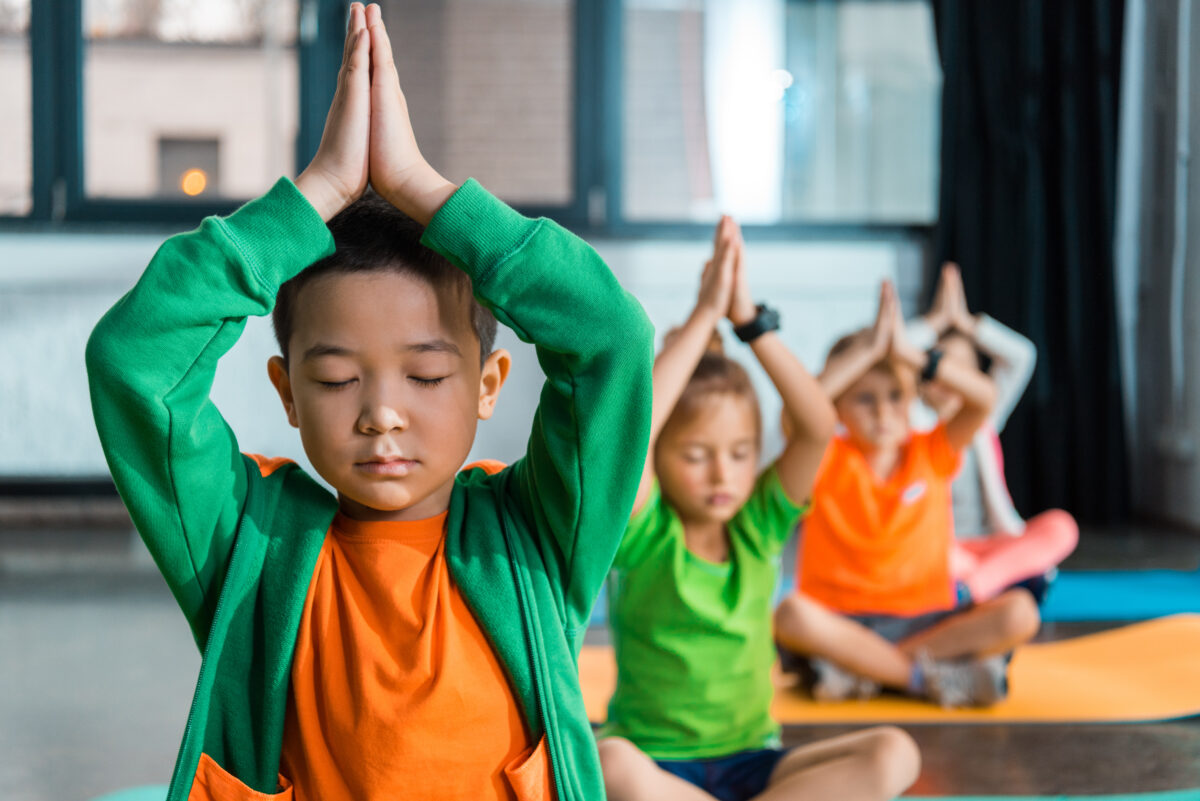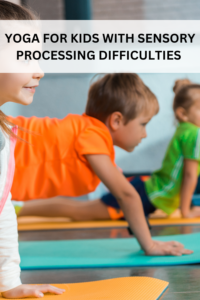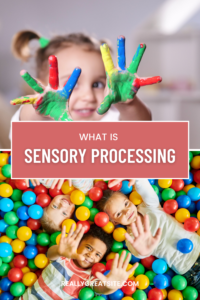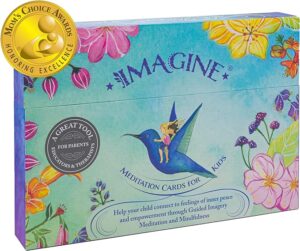
10 Amazing Benefits of Yoga for Kids with Sensory Processing Difficulties
Have you considered trying yoga for kids with sensory processing difficulties? Maybe you are a parent or caregiver of a child with unique sensory needs.
Or you’re a therapist or educator working with children with sensory processing difficulties. Yoga has so many amazing benefits, including supporting the development and regulation of the nervous system.
This post was created by Marra Robert, OTD, OTRL, and contains affiliate links.

Every child is unique, and for those with sensory processing difficulties, everyday life can be filled with challenges. Sensory processing issues can make it difficult for children to regulate their emotions and engage in typical daily activities.
As a parent, you may be searching for holistic and effective ways to help your child find balance, calm, and emotional stability. One promising avenue for achieving this is yoga.
Hi! My name is Marra and I’m a mama and a pediatric occupational therapist with years of experience working with children with various sensory processing needs and helping their parents navigate the ups and downs of child development.
I loved supporting parents learning about autism, sensory processing, and their child’s individual needs and providing resources to support their child. I often used yoga in my therapy treatments because of its amazing impact on the sensory systems.
Yoga is an incredible tool to use to help your child with sensory processing difficulties .In this post we will discuss all of the amazing benefits of yoga for kids with sensory processing difficulties.

Understanding Sensory Processing Difficulties
Before we explore the benefits of yoga for children with sensory processing difficulties, it’s essential to have a basic understanding of what sensory processing issues entail.
Sensory processing refers to the way our nervous system receives, organizes, and interprets sensory information from our environment.
We take in information through our 8 sensory systems and process it before we choose an appropriate response. Yes! We do have 8 sensory systems.
We have the 5 sensory systems we are all most familiar with: what we see, here, smell, taste, and touch. We have 3 additional sensory systems that are less well known: our vestibular, proprioception, and interoception sensory systems.
Our vestibular sense is our sense of movement and response to gravity. It is how we stay balanced. Our proprioceptive sensory system is our sense of deep pressure and body awareness. Interoception is our sense of how our body is feeling.
If you would like to learn more about sensory processing or our 8 sensory systems, check out the post linked below.

For some children processing all of the incoming sensory information that they are constantly receiving can be challenging, resulting in sensory processing difficulties.
These difficulties can manifest in various ways, including hypersensitivity (over-responsiveness) or hyposensitivity (under-responsiveness) to sensory input.
Sensory processing difficulties can lead to emotional dysregulation, stress, and even meltdowns. It’s important to note that these issues exist on a spectrum, and every child’s experience is unique.
While some children may have mild sensitivities, others may have more challenges. It’s crucial to consult with healthcare professionals and occupational therapist for a comprehensive evaluation if you suspect your child has sensory processing difficulties.

Yoga as a Therapeutic Tool
Yoga is an ancient practice that has been proven to be therapeutic for individuals of all ages, including children with sensory processing difficulties. The core principles of yoga, which include mindfulness, deep breathing, and gentle movement, can be particularly effective in helping children regulate their sensory experiences and emotional responses.
Here are some ways in which yoga benefits children with sensory processing issues:
1. Sensory INTEGRATION
Yoga provides a structured environment in which children can practice sensory integration. Through various poses, they learn to explore their bodies and the different sensations they experience, helping them become more attuned to their sensory needs and gradually desensitize themselves to overwhelming stimuli.
2. Improve Body Awareness
Yoga helps children develop a better understanding of their bodies, which is especially valuable for those with difficulty processing proprioceptive and vestibular sensory input. This improved body awareness can lead to better motor skills, coordination, and spatial orientation.
Through yoga, children learn to tune into their bodies and sensory experiences. This heightened awareness can help them recognize and manage sensory challenges, such as tactile sensitivities or auditory hypersensitivity.
3. Stress Reduction
Yoga emphasizes relaxation techniques and deep breathing, which can significantly reduce stress and anxiety. This is essential for children with sensory processing difficulties, as high stress levels can exacerbate sensory challenges.
Yoga helps children find calm and reduce stress, which can be especially important for those who experience sensory overload. The breathing techniques and mindfulness practices taught in yoga enable children to relax and cope with overwhelming sensory input more effectively.
4. Emotional Regulation
Yoga teaches children how to manage their emotional responses and self-soothe. This can be a valuable tool for preventing sensory-related meltdowns and tantrums.
Yoga provides children with tools to regulate their emotions and sensory responses. Techniques like deep breathing and self-soothing postures can be used to prevent meltdowns and emotional dysregulation.
5. Improved Concentation
Yoga encourages mindfulness, which enhances focus and attention. This can be especially beneficial for children who struggle with sensory overload and find it challenging to concentrate in busy or noisy environments.
6. Social Interaction
Participating in yoga classes with other children can help your child develop social skills, build confidence, and feel a sense of belonging
7. Improved Motor Skills
Yoga involves various poses and movements that can improve a child’s balance, coordination, and motor skills. This is particularly helpful for children with proprioceptive and vestibular sensitivities.
8. Boost to Self Confidence
Successfully mastering yoga poses and experiencing the benefits of yoga can boost a child’s self-esteem and confidence. This can lead to a more positive self-image, which is crucial for emotional well-being.
9. Improved Sleep
Many children with sensory processing difficulties struggle with sleep. Yoga can help regulate the nervous system, leading to better sleep patterns and improved overall well-being.
10. Empowerment
Yoga empowers children to take control of their sensory experiences. As they become more adept at managing their responses, they gain a sense of autonomy and empowermen
Tips for Introducing yoga for kids with sensory processing difficulties
Now that we’ve explored the benefits of yoga, here are some practical tips to help you introduce yoga into your child’s life:
1. Start Slowly: Begin with short, simple yoga sessions to gradually introduce your child to the practice. As they become more comfortable, you can increase the duration and complexity of the sessions.
2. Choose a Quiet Environment: Select a quiet, clutter-free space for your yoga sessions to minimize sensory distractions.
3. Use Visual Aids: Visual aids like pictures, charts, or videos can help children understand and follow yoga poses.
4. Consistency is Key: Consistency is important for any therapy or practice. Try to establish a regular yoga routine that your child can rely on.
5. Keep It Playful: Make yoga fun by turning it into a game or story. Incorporate imaginative play and storytelling into your yoga sessions to engage your child’s interest.
6. Respect Their Sensitivities: Be mindful of your child’s sensory sensitivities and adapt the practice accordingly. Avoid poses or activities that may trigger discomfort or anxiety
7. Offer Choices: Allow your child to choose some of the yoga poses they want to practice. This gives them a sense of autonomy and control.
8. Encourage Mindfulness: Teach your child to pay attention to their breath, sensations, and emotions during yoga sessions. Mindfulness is a valuable skill for emotional regulation.
9. Model the Practice: Practice yoga with your child to set a positive example and make it a shared experience.
10. Seek Professional Guidance: Consider enrolling your child in a children’s yoga class led by a certified yoga instructor who has experience working with children with sensory processing difficulties. This can provide a structured and supportive environment for your child to learn and grow.
Resources to Promote Yoga for Kids with Sensory Processing difficulties

This is a great resource to learn more about the benefits of yoga for kids with sensory processing difficulties as well as kids with autism and other needs. It’s very through and offers teaching suggestions as well.

These cards are so helpful when promoting yoga for kids with sensory processing difficulties. They offer great visuals for those kids who may have more difficulty processing auditory language.

These cards are a great way to promote mindfulness as well as yoga for kids with sensory processing difficulties.
Yoga is a holistic and effective approach to help children with sensory processing difficulties thrive. By promoting sensory awareness, emotional regulation, and self-esteem, yoga offers numerous benefits that can significantly improve your child’s quality of life.
Remember that every child is unique, and it may take time to find the right approach and routine that works for your child. Be patient and supportive as you explore the world of yoga together. Seek the guidance of healthcare professionals and therapists to ensure that yoga aligns with your child’s needs and complements their existing therapies.
Incorporating yoga into your child’s daily life can be a rewarding journey, fostering emotional well-being, improved sensory integration, and a sense of empowerment. By embracing the calming power of yoga, you can help your child navigate their sensory challenges with confidence and resilience.
